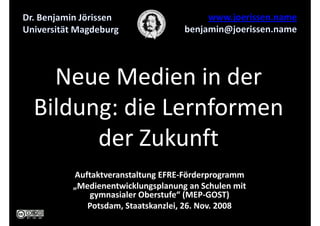
Neue Medien in der Bildung: Die Lernformen der Zukunft
- 1. Neue Medien in der Bildung: die Lernformen der Zukunft Auftaktveranstaltung EFRE-Förderprogramm „Medienentwicklungsplanung an Schulen mit gymnasialer Oberstufe“ (MEP-GOST) Potsdam, Staatskanzlei, 26. Nov. 2008
- 2. 1) Medien und Bildung 2) Schule und (neue) Medien 3) Bildungsaspekte jugendlicher Medienwelten 4) Handlungsbedarfe
- 3. 1) Medien und Bildung
- 4. Der Mensch als „animal symbolicum“ (E. Cassirer)
- 5. Der Mensch als „animal symbolicum“ (E. Cassirer) ist in mediale Weltverhältnisse eingelassen.
- 6. Seine Weltverhältnisse verändern sich mit wandelnden Medien grundlegend.
- 7. Gesellschaften und Kulturen verändern sich mit wandelnden Medien grundlegend. (McLuhan)
- 8. Verweisungsgefüge Kultur/ Gesell- schaft Medien Individuum
- 9. Verweisungsgefüge • Lernen Kultur/ • Aufbau von Gesell- Orientierungswissen schaft • Entwicklung von Welt- und Selbstverhältnissen Medien Individuum
- 10. Medien und Bildung Strukturen kultureller Leitmedien bestimmen Kultur/ die Strukturen von Gesell- schaft Bildung- und Lern- prozessen Medien Individuum
- 11. zunehmende Komplexität moderner Kommunikationsmedien Grafik: © Alexandra Bubenheim, alexandra.bubenheim@gmx.de
- 12. zunehmende Komplexität moderner Kommunikationsbedarfe Grafik: © Alexandra Bubenheim, alexandra.bubenheim@gmx.de
- 13. zunehmende Komplexität medialer Orientierungsoptionen Grafik: © Alexandra Bubenheim, alexandra.bubenheim@gmx.de
- 14. zunehmende Komplexität der Orientierungsnotwendigkeiten Grafik: © Alexandra Bubenheim, alexandra.bubenheim@gmx.de
- 15. zunehmende Komplexität medialer Lern- und Bildungspotenziale Grafik: © Alexandra Bubenheim, alexandra.bubenheim@gmx.de
- 16. zunehmende Komplexität der Anforderungen an Bildung Grafik: © Alexandra Bubenheim, alexandra.bubenheim@gmx.de
- 17. Medien und Bildung Strukturen kultureller Leitmedien bestimmen Kultur/ die Strukturen von Gesell- schaft Bildung- und Lern- prozessen Medien Individuum
- 18. 2) Schule und (neue) Medien
- 19. neues Medium: Buch (15. Jh.)
- 22. Zentrale Struktureigenschaft: linearer Aufbau → Kontrolle von Lerninhalten
- 23. Verweisungsgefüge Kultur/ Gesell- schaft Medien Individuum
- 24. Verweisungsgefüge Schule Medien Individuum
- 25. Verweisungsgefüge • Buch • Tafel Schule • Heft • Kopie alte ... Medien Individuum
- 26. Verweisungsgefüge ? Schule • Soziale Netz- neue werke Medien • Weblogs • Wikis Individuum • Youtube • Computerspiele
- 27. Schule als Institution einer literalen Kultur ist mit nicht- linear strukturierten Medien nicht kompatibel. Forderung der Umstrukturierung schulischer Bildungsarchitekturen. Jeanette Böhme: Schule am Ende der Buchkultur. Medientheoretische Begründungen schulischer Bildungsarchitekturen. Bad Heilbrunn: Klinkhardt 2006.
- 28. Wie?
- 29. Verweisungsgefüge ? Schule neue Medien Individuum
- 31. individualisierte, aktive, medienkonvergente Gestaltung medialer Alltagswelten
- 32. Wo liegen Lern- und Bildungspotenziale?
- 33. Wo liegen Lern- und Bildungspotenziale? Kulturelle Komplexität (Jenkins) Immersive Didaktik (Bopp) Regelkompetenzen (Juuls) Dezentrierung, Reframing (Fromme)
- 34. Wo liegen Lern- und Bildungspotenziale? „identity performance“ (Boyd) Alltagskreativität (Burgess) Artikulation, Partizipation (Marotzki)
- 35. Wo liegen Lern- und Bildungspotenziale? (vernetztes multimediales) Handy als kulturelle Ressource: mediales Handeln im Kontext von Medienstruktur, Agency und kulturellen Praktiken (Bachmair)
- 36. Schlüsselkompetenzen (heutiger und zukünftiger) gesellschaftlicher Partizipation Kulturelle Partizipation, Selbstkompetenzen, Kreativer Selbstausdruck, Kommunikation, Aushandlungsprozesse, Orientierungswissen, … Vernetzung, …
- 37. Schlüsselkompetenzen (heutiger und zukünftiger) gesellschaftlicher Partizipation Bildung in medialisierten Welten: „Medienbildung“
- 38. „Digital Natives“ versus „Digital Immigrants“
- 39. „The Internet has unleashed an explosion of creativity […] These new forms are unlike anything the world has ever seen before. Digital Natives are increasingly engaged in creating information, knowledge, and entertainment in online environments.“ (112)
- 40. 90 (nach Gescheidle/Klinger 2007) 80 70 60 14-19 50 20-29 40 30-39 40-49 30 50-59 20 60 + 10 0
- 41. divergente Nutzungsstile – abhängig vom Bildungshintergrund Wagner, U. & Theunert, H. (2006). Neue Wege durch die konvergente Medienwelt. München.
- 42. Chancen Gefahren Partizipation Datenschutz Artikulation Self-Disclosure Cybermobbing, Networking Übergriffe
- 43. (Auch) „Digital Natives“ brauchen Unterstützung NEW (SOCIAL) NEW FRONTIER
- 44. (Auch) „Digital Natives“ brauchen Unterstützung
- 45. Wer hilft? Chip-Studie „Kids am Computer“, März 2008
- 46. 90 (nach Gescheidle/Klinger 2007) 80 70 60 14-19 50 20-29 40 30-39 40-49 30 50-59 20 60 + 10 0
- 47. Verschärfung der Bildungskluft droht soziale ... … … Ungleichheit Migrations- digitale hintergründe Ungleichheit Bildungs- kluft
- 48. 4) Handlungsbedarfe und -möglichkeiten
- 49. Diagnose: • Digitale Medien werden zu Alltagsmedien
- 50. Diagnose: • Digitale Medien werden zu Leitmedien im Hinblick auf Bildungs- und Lernprozesse
- 51. z.B.: zukünftiges Lernen in Unternehmen MMB-Trendmonitor I/2008: Learning Delphi 2008 – Weiterbildung und Digitales Lernen heute und in drei Jahren. http://www.mmb-institut.de/2004/pages/trendmonitor/Trendmonitor-Downloads/Trendmonitor_I_2008.pdf
- 52. Diagnose: • „Screen Literacy“ wird zu einer neuen, komplexen Schlüsselkompetenz: Digitale Ungleichheit droht die Bildungskluft zu vertiefen
- 53. mediale Mediale Medien- Schul- bildung Schulkultur entwicklung
- 54. mediale mediale Medien- Schul- Schulkultur bildung entwicklung
- 55. Handlungsbedarf →Gemeinsame Maßnahmen im großen Maßstab – Wissenschaft, Politik, Wirtschaft – sind erforderlich, um neue digitale Bildungs- und Lernräume verantwortlich zu gestalten.
- 57. Potenzial vorhanden, Situation optimierbar
- 58. Potenzial vorhanden, Situation optimierbar European Commission: Benchmarking Access and Use of ICT in European Schools 2006. http://ec.europa.eu/information_society/eeurope/i2010/docs/studies/final_report_3.pdf
- 59. Was machen die anderen?
- 61. Partnership for 21st Century Skills In an economy driven by innovation and knowledge … in marketplaces engaged in intense competition and constant renewal … in a world of tremendous opportunities and risks … in a society facing complex business, political, scientific, technological, health and environmental challenges … and in diverse workplaces and communities that hinge on collaborative relationships and social networking … the ingenuity, agility and skills of the American people are crucial to U.S. competitiveness.
- 62. OpenNetworx / SchoolNetworx: Netzwerkkompetenz für Schüler und Lehrer
- 63. Vielen Dank für Ihre Aufmerksamkeit! Ressourcen: http://joerissen.name http://delicious.com/joeriben/schule2.0 http://groups.diigo.com/groups/web-20-bildung_soziales
